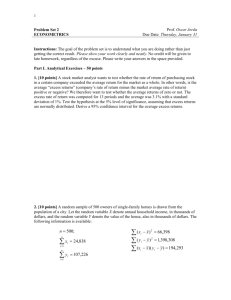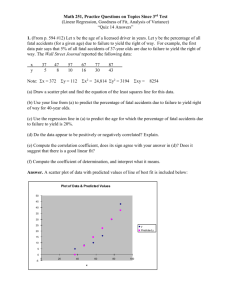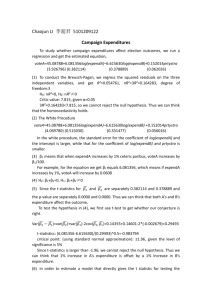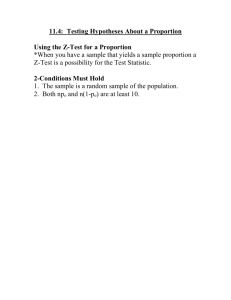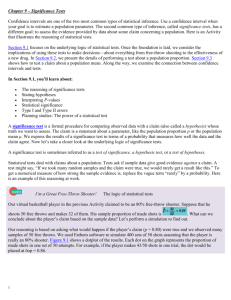In these two questions, we are given the answers and told to write
advertisement
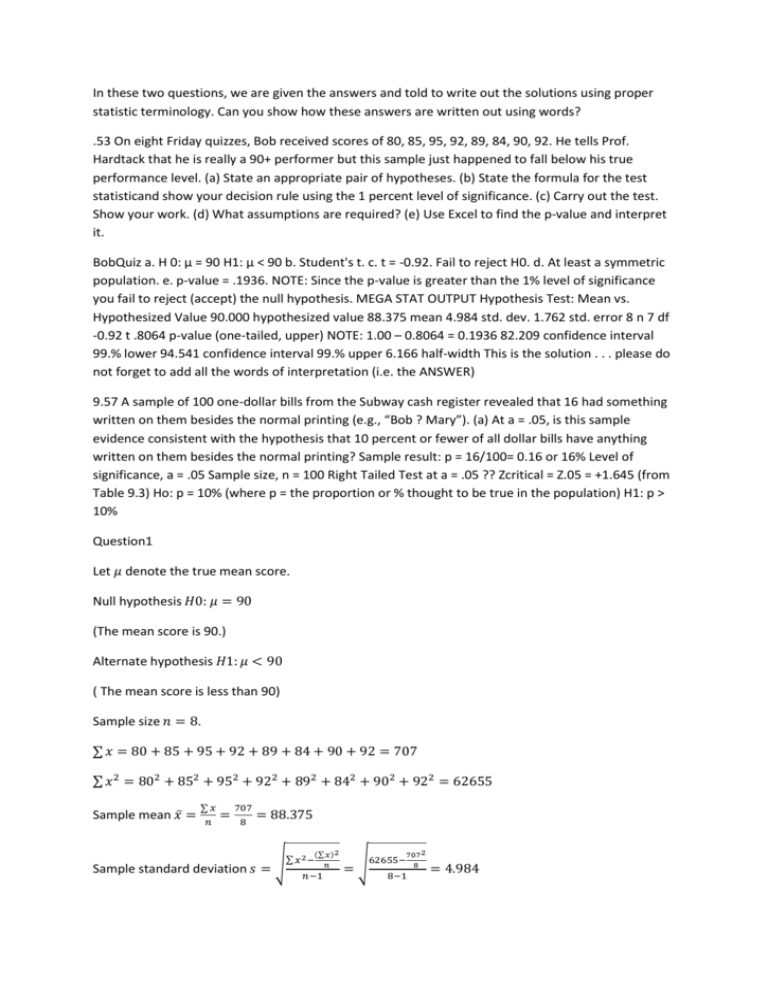
In these two questions, we are given the answers and told to write out the solutions using proper statistic terminology. Can you show how these answers are written out using words? .53 On eight Friday quizzes, Bob received scores of 80, 85, 95, 92, 89, 84, 90, 92. He tells Prof. Hardtack that he is really a 90+ performer but this sample just happened to fall below his true performance level. (a) State an appropriate pair of hypotheses. (b) State the formula for the test statisticand show your decision rule using the 1 percent level of significance. (c) Carry out the test. Show your work. (d) What assumptions are required? (e) Use Excel to find the p-value and interpret it. BobQuiz a. H 0: µ = 90 H1: µ < 90 b. Student's t. c. t = -0.92. Fail to reject H0. d. At least a symmetric population. e. p-value = .1936. NOTE: Since the p-value is greater than the 1% level of significance you fail to reject (accept) the null hypothesis. MEGA STAT OUTPUT Hypothesis Test: Mean vs. Hypothesized Value 90.000 hypothesized value 88.375 mean 4.984 std. dev. 1.762 std. error 8 n 7 df -0.92 t .8064 p-value (one-tailed, upper) NOTE: 1.00 – 0.8064 = 0.1936 82.209 confidence interval 99.% lower 94.541 confidence interval 99.% upper 6.166 half-width This is the solution . . . please do not forget to add all the words of interpretation (i.e. the ANSWER) 9.57 A sample of 100 one-dollar bills from the Subway cash register revealed that 16 had something written on them besides the normal printing (e.g., “Bob ? Mary”). (a) At a = .05, is this sample evidence consistent with the hypothesis that 10 percent or fewer of all dollar bills have anything written on them besides the normal printing? Sample result: p = 16/100= 0.16 or 16% Level of significance, a = .05 Sample size, n = 100 Right Tailed Test at a = .05 ?? Zcritical = Z.05 = +1.645 (from Table 9.3) Ho: p = 10% (where p = the proportion or % thought to be true in the population) H1: p > 10% Question1 Let 𝜇 denote the true mean score. Null hypothesis 𝐻0: 𝜇 = 90 (The mean score is 90.) Alternate hypothesis 𝐻1: 𝜇 < 90 ( The mean score is less than 90) Sample size 𝑛 = 8. ∑ 𝑥 = 80 + 85 + 95 + 92 + 89 + 84 + 90 + 92 = 707 ∑ 𝑥 2 = 802 + 852 + 952 + 922 + 892 + 842 + 902 + 922 = 62655 Sample mean 𝑥̅ = ∑𝑥 𝑛 = 707 8 = 88.375 ∑ 𝑥2− Sample standard deviation 𝑠 = √ (∑ 𝑥)2 𝑛 𝑛−1 7072 8 62655− =√ 8−1 = 4.984 The test statistic is 𝑡 = √𝑛(𝑥̅ −𝜇0 ) 𝑠 = √8(88.375−90) 4.984 = −0.92 Degrees of freedom = 𝑛 − 1 = 8 − 1 = 7 The lower tail critical value of 𝑡 with 7 degrres of freedom and level of significance 𝛼 = 0.01 is -2.998. The null hypothesis will be rejected if the computed value of 𝑡 is less than -2.998. As the computed value of 𝑡 is -0.92 and is not less than the critical value -2.998, the sample does not provide sufficient evidence to reject the null hypothesis. Bob’s claim cannot be accepted. The p-value of the test is 𝑃(𝑡 < −0.92) = 0.194 The null hypothesis will be rejected if the p-value is less than the significance level. Here the p-value 0.194 is not less than the significance level 0.01. So the null hypothesis cannot be rejected. Bob’s claim cannot be accepted. We have made use of the assumption that the distribution of score is normally distributed and that the sample is a random sample. Question 2 Let 𝑝 denote the true proportion of one-dollar bills having something written on it. Null hypothesis 𝐻0: 𝑝 = 0.10 The proportion of one-dollar bills with something written on it is 10%. Alternate hypothesis 𝐻1: 𝑝 > 0.10 The proportion of one-dollar bills with something written on it is greater than 10%. Sample size 𝑛 = 100. Sample proportion 𝑝̂ = The test statistic is 𝑧 = 16 100 = 0.16 𝑝̂−𝑝0 𝑝 (1−𝑝0 ) √ 0 𝑛 = 0.16−0.10 0.10(1−0.10) 100 =2 √ Level of significance 𝛼 = 0.05 Upper 5% critical value of 𝑧 is 1.645. The null hypothesis will be rejected if the computed value of 𝑧 is greater than 1.645. The computed value of 𝑧 is 2 and is greater than 1.645. The sample provides enough evidence to reject the null hypothesis. So we conclude that the sample proportion is greater than 10%. The p value is 𝑃(𝑧 > 2) = 0.02275 and it is less than 𝛼 = 0.05. The sample provides enough evidence to reject the null hypothesis. So we conclude that the sample proportion is greater than 10%.







